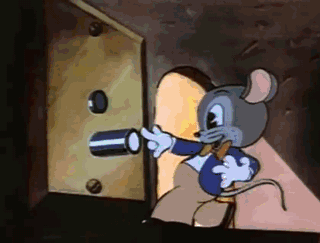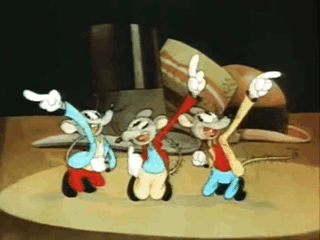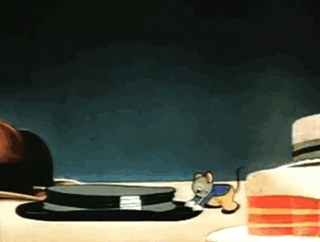Release date: August 21st, 1937
Series: Merrie Melodies
Director: Tex Avery
Starring: Berneice Hansell (Girl Mouse), Mel Blanc (Sheriff, George Washington, Blind Mouse, Shrieking), Billy Bletcher (Villain), Tex Avery (Andy Devine, Preacher), The Sportsmen Quartet (Chorus)
The second entry in his mice trilogy (that is, Ain’t We Got Fun, this, and The Mice Will Play), Tex Avery revisits the roots of earlier Merrie Melodies to give us this cutesy tale about mice running rampant in a hat shop at night.
Akin to the countless of other “come to life at night” cartoons of both the past and future, we open to the façade of a hat shop – Snobby Hatte Shoppe, that is. The streamlined, Art Deco exterior feels straight out of a Frank Tashlin cartoon. Truck inside with a multi-plane pan across the dark, empty, vast shop. Very moody and eye-catching.
A mouse hole in the wall is now the focus of the camera, where a trepidatious mouse pokes his head out warily. He tiptoes furtively along–the foreshortening and perspective on the backgrounds is very nice, again quite Tashlin-esque–the shop, pausing right out in the open.
Silence except for the music score… until, in an unmistakably Avery move, the mouse bellows “HEY! ANYBODY HERE!?” Without waiting for an answer, he darts back into his hole.
The coast is clear. Delighted, the mouse hops into his conveniently placed elevator, leading right towards a light switch. This cartoon does take extra steps to make lighting a priority, but some cases are more successful than others: as the elevator doors open, revealing a pool of light, the mouse momentarily becomes transparent as he passes the open door, thanks to difficulty with the double-exposure. Nevertheless, Mr. Mouse turns on the lights, prompting the black button above the on/off switch to ram right into his face, sending him falling to the ground and landing safely on top of a top hat.
Mr. Mouse asserts that he and his mice friends have no company: they’re free to party. After all of the mice have swarmed the place from their hole, the mouse proves himself to be a Casanova as he chews the shape of a heart into the wood to impress his sweetie, voiced by the giggly Berneice Hansell. His efforts pay off as his girl croons “Oh George, you’re so cute!” I’ll never get tired of hearing Hansell’s squeaky voice for as long as I live.
The love-birds run to join their friends, but have unexpected company: a nefarious, Billy Bletcher voiced mouse. Yes, folks! It’s a kidnapping picture! The kind that dominated the first 5 years of Warner Bros. cartoons all too prominently!
In preparation for the song number, both mice coyly pose with the hats mentioned in the song, with villain mouse crawling under a nefarious looking cap of his own to keep a keen eye out on the missus. The pans from the lovebirds to the villain is well executed. It’s not as blindingly fast as Frank Tashlin’s transitions, but it doesn’t need to be, either. There’s definitely a level of control present, which works to the cartoon’s advantage and disadvantage. Primarily the latter.
A mouse turns off the light-switch, another turning on a headlamp to use as a spotlight, which segues us into our song number. The song number is cute, but that’s about all it is. It’s surprisingly prominent, calling back to the earlier days of the Merrie Melodies where the songs were full-on songs, not sharp, witty, tongue-in-cheek quips as was becoming the norm for 1937.
Another pan demonstrates that the sunbonnet blue and the yellow straw hat getting wedded. The song sequence is unremarkable, but there is a bit of that Avery bite as we get a rather dismal view of married life: sunbonnet mama is doing all of the housework while straw hat dad reads the paper, paying no mind to their plethora of children running around.
We’re treated with more lighting effects as the mouse operating the headlamp now uses colored visors as a substitute for lighting gels. Some of the colors certainly translate better than others. Nevertheless, the happy couple are greeted with cheers and applause after their cutesy little number is complete.
Thankfully, Irv Spence swoops in to save the day from monotony, adding some much-needed zest and fervor with his animation of “The Three Ratz Brothers”. The clumsy brothers perform a vaudeville routine after breaking out of a dunce cap, singing “I Haven’t Got a Hat”, the Merrie Melody that marks the debut of Porky, Beans and co. just 2 years prior. The entire Ratz Bros. sequence is very well done and difficult to capture in photos and words: one of those scenes that you need to see for yourself. Irv’s poses are strong, defined yet loose and rubbery, and his facial expressions are satisfyingly goofy.
The rats burst into a medley of songs, the mood drastically changing as the engineer mouse from before switches out gels. Green lighting sparks a mournful dirge of “I Haven’t Got a Hat” (with one of the brothers even crying hysterically), yellow lighting prompts one of the brothers to recite Ted Lewis’ catchphrase of “Is everybody happy?” Lighting turns blue to reflect the unanimous outcry of “NO!”
Again, this is a great sequence–THIS is what Tex Avery is about. It’s strikingly noticeable that his heart wasn’t quite in this short, but for just a minute, he’s allowed to get a word in. Song numbers change, as do moods, as do colors, the rapid pace transitions once again Tashlin-esque in their execution. The three brothers end the number in a lively rendition of “The Lady in Red”, staring at the audience with crossed eyes and big grins. Gone too soon!
With the festivities over and done with, the peace now serves as the perfect transition for some prime kidnapping. The villain mouse sneaks up to the girl using his hat as a cover, and, predictably, snatches her away. George does a bit of an Avery take as his ears elongate in shock–he rushes to bang a spoon against a nearby military hat. They’d have plenty of military gags to work with in the coming years, as we’ll most definitely see once WWII breaks out. For now, George summons his army of mice to go after the villain and save the day.
Memories of Harman and Ising past revisit us once again as we get a taste of a tried and true–well, mainly tried–gag: mouse blows trumpet, prompting his pants to fall down. More hat gags, such as a line of mice marching beneath band leader’s hats with merely their legs exposed, until Irv Spence breaks up the monotony by animating a rat sheriff resting beneath a sheriff’s hat.
George hurriedly alerts him to his dilemma, prompting the sheriff to exclaim “WHY DOESN’T SOMEBODY TELL ME THESE THINGS!?”, a catchphrase whose origin is a bit muddy–some attribute it to radio show personality Fred Allen, others to a Listerine commercial, and it’s even the name of a song. Nevertheless, Spence’s animation is lively like always, his zest not taken for granted.
After the sheriff blows on his whistle, summoning a police and fire brigade (all spawning from police hats and fireman hats respectively), a mouse hiding beneath a cowboy hat bellows “BUCK BENNY RIDES AGAIN!”, prompting a slack-jawed, hayseed mouse to respond “Hello, Buck!”
Both are a reference to Jack Benny’s radio show, particularly Jack Benny’s cowboy persona, (as you can guess) Buck Benny. Elsewhere, we get some more gags of the mice and their “factions”, including football playing mice and their respective cheerleaders. Finally, we get a distance shot of all of the hats running together. It’s a nice bit of animation, and the lively underscore of “I Haven’t Got a Hat” does contribute an air of jolliness to the sequence.
Elsewhere, George darts through rows of hats, the sounds coming out of his mouth being the unmistakable laugh of Daffy Duck’s. In the midst of his frantic HOOHOO!ing, George stumbles upon another George: Washington.
Once again, Irv Spence animates the exchange between both mice, the Regular George asking “Which way did they go?”, prompting Washington to arbitrarily tack on “I cannot tell a lie: they went that way.” The scene has potential to be funny–I would have loved to have seen the Washington mouse act all uppity and snooty–but falls rather flat instead.
We’re treated with a blind mouse gag who points George in the direction of the chase. Kidnapper and victim dash over a staircase of meticulously placed hats, pursued by George. George jumps onto a top hat, flattening it, and then swings the hat around like a frisbee. The frisbee effectively slides beneath the villain, sending him sliding. Again, another spence scene, with some rather intriguing animation, especially that of George winding up the hat to throw.
The villain loses the girl in the process, and now flies empty handed into a knight’s helmet after the top hat springs up and launches him across the room. George closes the helmet, placing the villain in “jail”, prompting him to grumble the ever popular Fibber McGee and molly catchphrase “t’ain’t funny, McGee!” Blanc voices the line instead of Billy Bletcher for reasons unbeknownst to me.
Meanwhile, the mouse sweethearts reunite. George excitedly whispers into his sweetie’s ear–she nods, prompting George to do a dance of excitement while the audience waits with bated breath.
Their grand secret? A wedding. The happy couple march down the aisle lined with hats, complete to a rather jazzy rendition of “Here Comes the Bride”. The officiator reflects a burst of Avery humor as he gives a hilariously abbreviated ceremony: “Do you…. dododododdododododo… do you?” “I do!”
With weddings come wedding gifts, and our mice are no exception. The bride does the honors of opening the box, and husband soon follows. Wife peers inside and grows rather bashful, a flurry of giggles. She encourages her husband to peer in–he does so, giving another Daffy-esque “WOOHOO!” of shock as he stares at the camera in befuddlement. We iris out on the big reveal, which also has the honors of being Tex Avery’s first use of live action in a cartoon:
This is a rather frustrating entry. I don’t like to hold Tex Avery up as if he’s some monolith–his cartoons aren’t perfect, as we see here. He has weaknesses and faults like everybody else. But the fact that we’ve seen what he’s capable of, it’s hard not to compare it to works like these: the letdown is inevitable. It’s clear his heart was not at all in this one. It instead feels like a Merrie Melody from the 1934-1935 season–the art style is the only thing boosting it from comparisons to Harman and Ising. It’s just not a strong entry at all. There’s hardly any bite to it, it plays the game much too safe.
Irv Spence’s scenes are the shining stars of the cartoon, especially that interlude with the Ratz brothers. That is true Avery, that is what he is capable of, but the rest of the cartoon just doesn’t follow through. Painfully formulaic, unremarkable, forgettable. You’re better than this, Tex!
I will give it points for artistic experimentation: the lighting effects, while not executed perfectly, were certainly ambitious, and some of the backgrounds are very tasteful. But, as a whole, this is a very forgettable cartoon that you can easily skip. Yet, for you curious types such as myself, link!














No comments:
Post a Comment